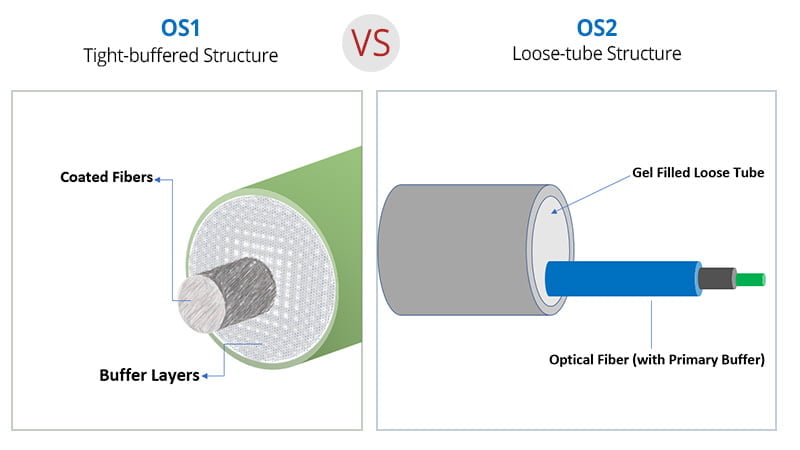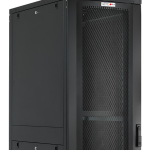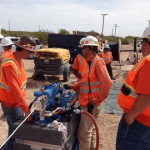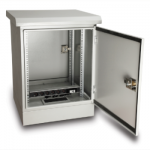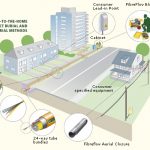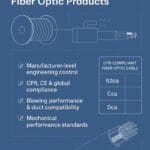25 Jan OS1 and OS2 Fiber Optic Cores
OS1 OS2 Fiber Cores are types of single mode fiber optic cables that are used for high-speed data transmission. OS1, or “single-mode,” cable has a small core (typically 9 microns in diameter) that allows for a single light beam to be transmitted over long distances with minimal loss. This type of fiber is commonly used in telecommunications and high-speed internet connections, where long-distance and high-data rate transmissions are required.
OS2 is a standard defined by the International Telecommunication Union – Telecommunications (ITU-T) that defines the requirements for single-mode optical fiber cables used in telecommunication applications. OS2 standard specifies the characteristics of the fiber, such as attenuation, modal bandwidth, and geometric parameters. This standard is used to ensure that the cables meet certain requirements for telecommunications applications, such as high-speed data transfer and long-distance signal transmission.
Both types of single-mode fibers use glass or plastic fibers to transmit light, and they are commonly used in telecommunications and networking applications. The choice between OS1 or OS2 will depend on the specific requirements of the application, such as the transmission distance, data rate, and environmental factors.

OS1 OS2 Attenuation Coefficient of Standard ITU-T G.652.A B C D
OS1 Fiber core
OS1 fiber is a type of optical fiber that is specifically designed for use in single-mode optical communication systems. It is defined by the International Telecommunication Union (ITU) as a fiber with a tighter tolerance for attenuation (loss of signal strength) than other types of fibers. OS1 fibers are typically used in long-distance telecommunications and high-speed data transmission applications.
Some of the features of OS1 fibers include:
- Low attenuation: OS1 fibers have a very low attenuation (typically less than 0.35 dB/km) which allows them to transmit data over long distances with minimal loss of signal strength.
- Single-mode operation: OS1 fibers are designed to support single-mode operation, which means that only one beam of light (mode) can propagate through the fiber. This allows for high data rates and bandwidths.
- High reliability: OS1 fibers are more reliable in harsh environments such as high temperatures and high humidity.
- High security: OS1 fibers are less vulnerable to eavesdropping because it is difficult to detect the signal transmitted through it.
Some of the application areas of OS1 fibers include:
- Long-distance telecommunications: OS1 fibers are commonly used in transcontinental or transoceanic undersea cables that need to transmit data over thousands of kilometers.
- High-speed data transmission: OS1 fibers are used in data centers and internet service providers to support high data rates and bandwidths.
- Industrial applications: OS1 fibers are used in industrial control systems, such as oil and gas pipelines, to transmit data and control signals over long distances in harsh environments.
In summary, OS1 fibers are high-performance fibers that are designed to transmit data over long distances with minimal loss of signal strength, they are used in long-distance telecommunications and high-speed data transmission, and they are more reliable in harsh environments.
OS2 Fiber core
OS2 fiber is a type of optical fiber that is defined by the International Telecommunication Union (ITU) as a fiber with a larger tolerance for attenuation (loss of signal strength) than other types of fibers. OS2 fibers are typically used in shorter-distance communication systems such as local area networks (LANs) and data centers. OS2 fibers are also known as “standard” fibers.
Some of the features of OS2 fibers include:
- High attenuation: OS2 fibers have a higher attenuation tolerance (typically less than 3 dB/km) compared to OS1 fibers which allows them to transmit data over shorter distances with acceptable loss of signal strength.
- Multi-mode operation: OS2 fibers are designed to support multi-mode operation, which means that multiple beams of light (modes) can propagate through the fiber. This allows for lower data rates and bandwidths compared to OS1 fibers.
- Flexibility: OS2 fibers are more flexible in terms of the types of equipment that can be used with them.
- Low cost: OS2 fibers are less expensive than OS1 fibers.
Some of the application areas of OS2 fibers include:
- Short-distance telecommunications: OS2 fibers are commonly used in local area networks (LANs) an
- d data centers to connect devices within a building or campus, and the distance between devices is relatively short (typically less than 10km).
- Industrial applications: OS2 fibers are used in industrial control systems, such as oil and gas pipelines, to transmit data and control signals over short distances in harsh environments, such as extreme temperatures and humidity.
- Residential: OS2 fibers are used in residential networks for internet and telephone services.
In summary, OS2 fibers are fibers that are designed for shorter-distance communication systems, they have a larger tolerance for attenuation, multi-mode operation and they are more flexible and less expensive than OS1 fibers.
What is the difference between OS1 and OS2 Fiber Cores?

OS1 OS2 Fiber Cores comparion table
The main difference between OS1 and OS2 fiber optic cables is primarily in their cable construction, not their optical fiber specifications.
OS1 type cables are typically of a tight buffered construction, where the optical fibers are surrounded by a tight-fitting buffer material, such as a plastic coating, to protect them from external damage. This construction is typically used for short-distance applications and provides a high level of protection for the fibers.
OS2 type cables are typically of a loose tube or blown cable construction, where the optical fibers are placed inside a loose-fitting tube, or are blown into a tube, rather than being tightly buffered. This construction is typically used for long-distance applications and allows the fibers to move freely inside the tube, reducing the amount of stress on the fibers.
It’s worth to mention that the tight buffered construction is more robust and easier to handle, while the loose tube construction is more flexible and allows the use of more fibers in the same cable.
In summary, the choice of OS1 or OS2 fiber optic cable depends on the application and the distance that the signal needs to travel, as well as the level of protection and flexibility required for the fibers.
Besides the standards, the main difference between OS1 OS2 Fiber Cores single mode fiber is primarily in their cable construction.
OS1 cabling is typically of a tight-buffered construction, where the optical fibers are surrounded by a tight-fitting buffer material, such as a plastic coating, to protect them from external damage. This construction is typically used for short-distance indoor applications, such as in campus or data center environments, where the fibers need to be protected from physical damage and where tight bend radius is required.
OS2 cabling is typically of a loose-tube design, where the optical fibers are placed inside a loose-fitting tube, rather than being tightly buffered. This construction is typically used for long-distance outdoor applications, such as in underground or aerial installations, where the fibers need to be protected from environmental factors such as temperature changes and water ingress, and where the fibers need to be able to move freely inside the tube to reduce the stress on the fibers.
It’s worth to mention that OS1 OS2 Fiber Cores have the same optical performance characteristics, such as attenuation and
The main difference between OS1 and OS2

OS1 OS2 Attenuation Coefficient of Standard ITU-T G.652.A B C D
The main difference between OS1 OS2 Fiber Core fiber is the cable construction, and the cable construction is closely related to the application and the environment where the cable will be used.
OS1 fiber is typically used in tight-buffered construction, which is a design that protects the fiber from external damage by surrounding it with a tight-fitting buffer material, such as a plastic coating. This construction is typically used for indoor applications, such as in buildings, data centers and campus networks, where the cable is protected from environmental factors like water and UV radiation.
OS2 fiber is typically used in loose-tube construction, which is a design that allows the fibers to move freely inside a loose-fitting tube, reducing the amount of stress on the fibers. This construction is typically used for outdoor and long-distance applications, such as underground and aerial installations, where the cable is exposed to the environment and needs to be able to withstand temperature changes and mechanical stress.
It’s worth noting that both OS1 OS2 Fiber Cores comply with ITU-T G.652 and ITU-T G.651 standards, respectively, for single-mode fibers, but the cable construction is the main differentiator for the application.
OS1 and OS2 fibers might be used in:
- OS1 fibers are often used in long-distance telecommunications networks, such as transcontinental or transoceanic undersea cables. These fibers need to transmit data over thousands of kilometers without significant loss of signal strength.
- OS1 fibers are also used in high-speed data transmission networks, such as data centers and internet service providers. These fibers need to support high data rates and bandwidths to keep up with growing demand for data-intensive applications.
- OS2 fibers are often used in local area networks (LANs) and data centers. These fibers are used to connect devices within a building or campus, and the distance between devices is relatively short (typically less than 10km).
- OS2 fibers are also used in industrial applications, such as oil and gas pipelines and industrial control systems. These fibers are used to transmit data and control signals over short distances in harsh environments, such as extreme temperatures and humidity.
In summary, OS1 fibers are designed for high-performance, long-distance telecommunications and high-speed data transmission while OS2 fibers are used for shorter-distance communication systems and in harsh environments.
Why OS1 and OS1 Fiber cores are confusing?
OS1 and OS2 are terms that are used in the fiber optic industry, but their usage can be confusing because they are not always used consistently or correctly. OS1 is often used to refer to single-mode fiber optic cable, but OS2 is not a term that is commonly used in the industry to describe a specific type of fiber optic cable. Instead, OS2 is a standard defined by the ITU-T (International Telecommunication Union-Telecommunications) that defines the requirements for single-mode optical fiber cables used in telecommunication applications.
In addition, the term “OS2” is sometimes used incorrectly to refer to multi-mode fiber, which is a different type of fiber optic cable with a larger core size that is used for shorter distance applications. This confusion can be caused by the fact that the terminology used in the industry is not always standardized and can vary from company to company, or even within the same company.
Advantages and disadvantages of OS1 and OS2 fiber to each other
OS1 OS2 Fiber Cores have different advantages and disadvantages depending on the application they are being used for.
Advantages of OS1 fibers:
- They have a tighter tolerance for attenuation (loss of signal strength), which allows them to transmit data over longer distances with less signal loss.
- They are typically used in single-mode optical communication systems, which allow for higher data rates and bandwidths.
- They are more reliable in harsh environments such as high temperatures and high humidity.
Disadvantages of OS1 fibers:
- They are more expensive than OS2 fibers.
- They require more specialized equipment and expertise to install and maintain.
- They are not as flexible in terms of the types of equipment that can be used with them.
Advantages of OS2 fibers:
- They have a larger tolerance for attenuation than OS1 fibers.
- They are typically used in shorter-distance communication systems, which can be less expensive to install and maintain.
- They are more flexible in terms of the types of equipment that can be used with them.
Disadvantages of OS2 fibers:
- They are less reliable in harsh environments such as high temperatures and high humidity.
- They are not suitable for very high-speed and high-bandwidth applications.
It’s important to note that the choice between OS1 and OS2 fibers will depend on the specific requirements of the application, such as the distance, data rate, environment, and budget.
Which of them is the newer or older version of technology?
OS1 and OS2 are two different categories of optical fibers defined by the International Telecommunication Union (ITU) based on their attenuation characteristics, and they are not considered as newer or older version of technology.
Optical fibers technology have been evolving and improving over time, with new types of fibers and new techniques being developed to improve performance, reduce costs, and increase capacity. Some examples of newer fiber technologies include:
- Bend-insensitive fibers: These fibers are designed to be more flexible and less susceptible to damage from bending, which makes them easier to install and more reliable in the long term.
- Ultra-low loss fibers: These fibers have extremely low attenuation (typically less than 0.1 dB/km) which allows them to transmit data over even longer distances with minimal loss of signal strength.
- Photonic crystal fibers: These fibers use a special structure called a photonic crystal to confine and guide light, which allows for higher data rates and bandwidths than traditional fibers.
- Non-zero dispersion-shifted fibers: These fibers are designed to reduce the effects of dispersion (the spreading of light over different wavelengths) which can cause signal distortion.
So it’s worth to note that there is a continuous research to improve the fibers technology, and new type of fibers with better performance and characteristics are being developed regularly.
OS1 or OS2 fiber core is indoor type?
Both OS1 and OS2 fibers can be used for indoor and outdoor applications. The choice of which type of fiber to use will depend on the specific requirements of the application.
OS1 fibers are typically used in long-distance telecommunications and high-speed data transmission applications, which are often used for outdoor applications such as transcontinental or transoceanic undersea cables or for high-speed data transmission networks like data centers and internet service providers. These fibers need to transmit data over long distances with minimal loss of signal strength.
OS2 fibers are typically used in shorter-distance communication systems, such as local area networks (LANs) and data centers. These fibers are used to connect devices within a building or campus, and the distance between devices is relatively short (typically less than 10km). OS2 fibers are also used in industrial applications, such as oil and gas pipelines and industrial control systems, where they are used to transmit data and control signals over short distances in harsh environments. These fibers are also used in residential networks for internet and telephone services.
In summary, both OS1 OS2 Fiber Cores can be used for indoor and outdoor applications, but OS1 fibers are typically used for long-distance telecommunications and high-speed data transmission while OS2 fibers are used for shorter-distance communication systems and in harsh environments, and also in residential networks.
Conclusion
OS1 OS2 Fiber Cores are terms used to refer to different types of single-mode fiber optic cables that are used for high-speed data transmission.
OS1 fiber is single-mode fiber that has a small core size, typically 9 microns in diameter, which allows for a single light beam to be transmitted over long distances with minimal loss. OS1 fiber is commonly used in telecommunications and high-speed internet connections, where long-distance and high-data rate transmissions are required.
OS2 is a standard defined by the International Telecommunication Union – Telecommunications (ITU-T) that defines the requirements for single-mode optical fiber cables used in telecommunication applications. OS2 standard specifies the characteristics of the fiber, such as attenuation, modal bandwidth, and geometric parameters. This standard is used to ensure that the cables meet certain requirements for telecommunications applications, such as high-speed data transfer and long-distance signal transmission.
It’s important to note that the terms OS1 and OS2 are not always used consistently or correctly in the industry, and confusion may arise due to the lack of standardization in the terminology used.
Construction Products Regulation (CPR) for Cables
CPR for cables (Construction Products Regulation) for cables became a legal requirement in July 2017. CPR for fiber optic cables is having an intended use for permanent installation in buildings and c...
No comment 0 LikesOptical Fiber
What is optical fiber? We are used to the concept of moving knowledge in numerous ways. A wire cable transports the sounds from our speech into a socket on the wall and is borne by another cabl...
No comment 8 Likes19″ Rack Cabinet
What is a 19” Free Standing Rack Cabinet? 19” free standing rack cabinets provide a robust, cost-effective enclosure solution. PDU mounting or connectivity on both the front and rear of the cabinet. T...
No comment 0 Likes5 Fan Facts About the Fiber Optic Cables
Fiber optic cables are a type of cable that use glass or plastic fibers to transmit data. Here are some interesting facts about fiber optic cables: Speed: Fiber optic cables are capable of transmittin...
No comment 4 LikesWhat is fiber optic cable
Fiber optic cables are an innovative communication medium that transmit data using light instead of electrical signals. Designed for efficiency and speed, these cables leverage thin strands of glass o...
No comment 4 LikesHow Much Does Fiber Optic Cable Installation Cost in 2025?
Fiber Optic Cable Installation Cost | Reduce Costs with Cable Blowing Machines – UPCOM How Much Does Fiber Optic Cable Installation Cost? Updated guide for telecom and infrastructure professionals (20...
No comment 4 LikesIP55 Outdoor Cabinet
We found out that there is no enough information about 19” IP55 Outdoor Cabinet and thus we will investigate it. If you are reading this article, then you are probably planning to make a procurement s...
No comment 3 LikesFTTH installation Technologies
FTTH installation technologies Table of Contents Innovative approach to FTTH installation Technologies…1 Infrastructure Sharing…2 Duct sharing in France…2.1 Sewer pipes…2.2 Cle...
No comment 1 LikeCable Blowing by Pressurized Air / Fiber Optic Cable Blowing Procedure
Cable Blowing (Sometime called air assisted cable blowing, Cable Blowing by Pressurized Air, air blowing, jetting and all these words are describing method of cable blowing with pressurized air) Cabl...
No comment 1 LikeWhat Distributors Should Know Before Importing Fiber Optic Products: A Technical & Manufacturer-Level Guide
A technical guide for distributors importing fiber optic products, covering manufacturer-level engineering standards, CPR compliance, blowing performance and key quality checks....
No comment 0 Likes


